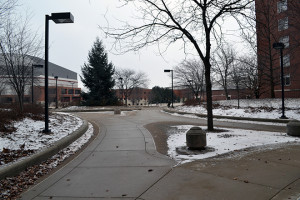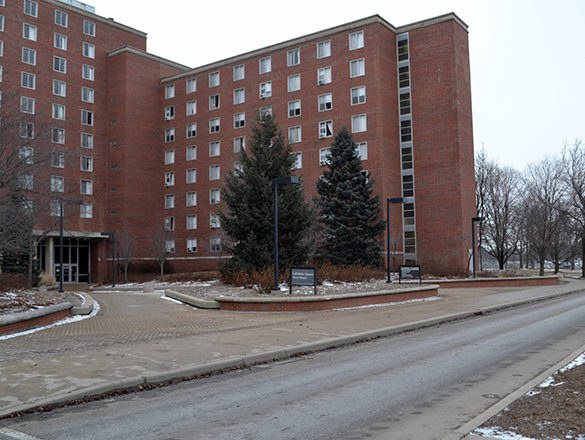
*Johnson’s real name has been omitted from this story, because it is Ball Bearing’s policy that we not include the name of sexual assault victims.
Kayla Johnson was walking back to her dorm alone at 9 p.m.; a 2012 Welcome Week event had just ended. It was her freshman year, and classes had not even started yet.
As she approached Lafollette, a tall, at least 300-pound white, bearded man with shaggy, brown hair was belligerently slurring words while talking on his phone. He was clearly upset about something.
Johnson walked near him when suddenly he grabbed her elbow and pulled her toward him.
“Hey, I wanna talk to you! I wanna talk to you!” he said.

He reeked of alcohol. Johnson was concerned for him, and asked if he lived in Lafollette and needed help getting to his room. She had been around intoxicated people before, so the fact that he grabbed her arm wasn’t very alarming.
“You think I live in Lafollette? I’m not no damn freshman!” he snarled.
It was then that the man pulled Johnson in closer with his arm around her waist. He pinned one of her arms vertically against his side and the other was bent and pinned against his chest.
“You don’t know me at all! Please stop!” Johnson pleaded with the man.
Johnson began squirming trying to free her bent arm against his chest. He then forced his mouth onto hers and began kissing her, followed by groping her breasts.
During these brief moments, Johnson’s mind was in a frenzy repeatedly thinking, “I don’t want to be a statistic. I don’t want to be a statistic.”
Angry and determined, Johnson managed to free one arm and used her palm to hit the man in the eye and force him backward. Although she was aiming for his nose, she hit with enough power to break free of his grip.
“You goddamn bitch!” he screamed. “You’re just a dirty slut and you know it!”
Trying to hold back her tears, not wanting to appear weak, Johnson commanded that the man leave immediately.
It was at this moment Johnson realized there was a group of freshmen women standing nearby, huddled together. Some were crying and one was on the phone. They had seen the entire event unfold and had called the University Police Department.
The man walked away after making a comment that he respected a woman who could stand up for herself.
Since the women were terrified, none of them ventured to keep an eye on him or to see where he was going.
Johnson stood with the group of women for around fifteen minutes before UPD arrived. During that time they were warning other women walking by that an intoxicated and dangerous man was nearby and they needed to be careful.
Johnson was never informed of why it took UPD so long to respond.
When UPD arrived, Johnson gave a description of her attacker. The officers soon left to search for the man, and never returned to inform her of their findings.
She was never asked if she wanted to file charges, nor was she given any advice about where to seek help as a survivor of sexual assault.
“I tried my hardest to counsel myself,” she said. “I didn’t want my friends to know I was a statistic.”
Johnson’s dreams of a perfect college experience were ripped away from her in the brief time that her attacker sexually assaulted her. She was scared away from participating in college parties, and was constantly reminding her friends to walk in groups at all times.
To this day, Johnson’s own family does not know about what took place that night. Throughout the years, she has only spoken of the event to around six of her very close friends.
Johnson found healing after her assault through completing the Elemental self-defense program offered by Ball State. She also completed the Rape Aggression Defense program that Ball State offers, but did not think that it was as impactful of a program.
The Office of Victim Services at Ball State is available for confidential support for those who are victims of sexual assault, relationship violence and stalking.
At the time, Johnson did not know the Office of Victim Services existed, nor did she know she could seek help from the counseling center.

“I think it’s possible people don’t utilize OVS because they don’t know it even exists,” said Allison Wynbissinger, who has been Ball State’s Victim Advocate since the fall of 2012. “If they do decide to report to the campus, they should be made aware that OVS exists.”
The Rape, Abuse & Incest National Network states that every 107 seconds another American is sexually assaulted. Women have the highest rate of sexual assaults; with 1 out of every 6 American women have been the victim of attempted or completed rape, along with 1 out of every 33 American men.
“It’s hard to get a very specific number on how much is happening here [at Ball State],” said Wynbissinger. “Sexual violence is the most underreported violent crime that exists.”
According to Ball State’s 2014 Camus Security Report, there were 17 forcible sex offenses on campus in 2013.
OVS provides different events throughout the year to inform students of their services. All housing staff members are informed of OVS, and for the first time this year, all residence halls on campus were required to do a sexual assault awareness program at the beginning of each semester.
According to RAINN, victims of sexual assault are three times more likely to suffer from depression, six times more likely to suffer from post-traumatic stress disorder, 13 times more likely to abuse alcohol, 26 times more likely to abuse drugs, and four times more likely to consider suicide.
“This is something that could happen to anyone,” said Wynbissinger. “The biggest thing is being a support person.”
Dr. Michael Gillilan is the Director of Student Rights and Community Standards. His office responds any Title IX violations, and then enforces the Code of Student Rights and Responsibilities.
Title IX violations are discriminations on the basis of gender, which encompasses sexual assault.
Gillilan reviews the final investigation report from Katie Slabaugh, the Associate Dean of Students and Title IX Coordinator for Student Affairs, when Title IX violations are brought to the attention of the university.
It is then decided if there needs to be further investigation, if there is insufficient information to conclude that the event more likely than not happened, or that there is sufficient information to go forward with adjudication.
If it is decided that there is sufficient information, the accused student has an opportunity to accept or deny responsibility in writing. If they deny responsibility, a review board hears the case, specifically, a new sexual misconduct review board created for this academic year. This board is comprised of three faculty members who review the case and then come to a decision of whether or not the accused student is responsible or not.
“We haven’t actually tested this yet,” said Gillilan. “We’ve had a number of cases; all of them have been resolved informally so far.”
This entire process of investigating and coming to a decision for cases of sexual misconduct is not supposed to take more than 60 days. However, there are times when it may take longer, and in those situations students will be given the reasoning as to why it is taking longer than expected.
“We’re trying to make it easier on both parties,” said Gillilan. “We’re trying not to have people tell their story any more times than they have to.”
Sanctions, or punishments, for student code violations can range from an official reprimand to expulsion. In cases of sexual assault where there is nonconsensual penetration, it is required to consider suspension as a sanction.
“We don’t want to overreact, but we don’t want to underreact,” said Gillilan. “I’m also looking very carefully at how we can try to address the harm that’s been done to the complainant.”
Johnson’s story is a rare example, a situation in which she did not know her perpetrator. According to the National Institute of Justice, nine out of 10 college women who are victims of sexual assault know their perpetrator. Since Johnson’s perpetrator was never identified, she did not bring her complaint forward to the university.
“I think it is the responsibility of our society to understand this is a problem and to deal with it,” said Johnson. “They’re perpetrators, they cause the problem. Are they the victims of a society that taught them that that was okay? Yeah, probably.”
[topswf swf=’http://ballbearingsmag.com/wp-content/uploads/2015/02/sexual-violence-chart-2-19.swf’ width=’1024′ height=’2050′ quality=’best’ wmode=’transparent’ scale=’default’ flashvars=” allowfullscreen=’false’]




